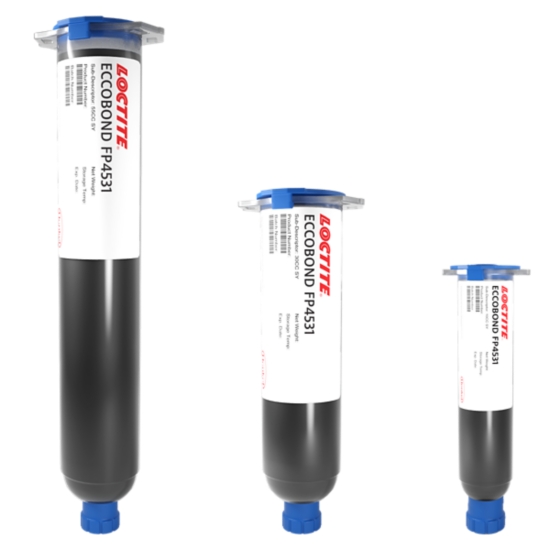LOCTITE ECCOBOND FP4531
Harmonization Code : 3907.30.00.90 | Polyacetals, other polyethers and epoxide resins, in primary forms; polycarbonates, alkyd resins, polyallyl esters and other polyesters, in primary forms : Epoxide resins : Other
Main features
- Snap cure
- Fast flow
- Passes NASA outgassing
Product Description
LOCTITE® ECCOBOND FP4531 underfill is designed for flip chip on flex applications with a 1mil gap. It is a snap curable epoxy with fast flow that passes NASA outgassing standards.
LOCTITE® ECCOBOND FP4531 is 62% filled, offers a pretty long pot life and has limited impurities. Its snap cure schedule can vary based on customer's experience and application requirements.
Snap Cure Schedule
- 7 minutes @ 160°C
Technical Specifications
| General Properties | |||||||||
| |||||||||
| Pot Life Pot Life Pot life is the amount of time it takes for the viscosity of a material to double (or quadruple for lower viscosity materials) in room temperature after a material is mixed. It is closely related to work life but it is not application dependent, less precise and more of a general indication of how fast a system is going to cure. | 24 hours | ||||||||
| |||||||||
| Physical Properties | |||||||||
| Viscosity Viscosity Viscosity is a measurement of a fluid’s resistance to flow. Viscosity is commonly measured in centiPoise (cP). One cP is defined as the viscosity of water and all other viscosities are derived from this base. MPa is another common unit with a 1:1 conversion to cP. A product like honey would have a much higher viscosity -around 10,000 cPs- compared to water. As a result, honey would flow much slower out of a tipped glass than water would. The viscosity of a material can be decreased with an increase in temperature in order to better suit an application | 10,000 mPa.s | ||||||||
| Chemical Properties | |||||||||
| |||||||||
| Electrical Properties | |||||||||
| |||||||||
| Thermal Properties | |||||||||
| |||||||||
| Glass Transition Temperature (Tg) Glass Transition Temperature (Tg) The glass transition temperature for organic adhesives is a temperature region where the polymers change from glassy and brittle to soft and rubbery. Increasing the temperature further continues the softening process as the viscosity drops too. Temperatures between the glass transition temperature and below the decomposition point of the adhesive are the best region for bonding. The glass-transition temperature Tg of a material characterizes the range of temperatures over which this glass transition occurs. | 161 °C | ||||||||
| Thermal Conductivity Thermal Conductivity Thermal conductivity describes the ability of a material to conduct heat. It is required by power packages in order to dissipate heat and maintain stable electrical performance. Thermal conductivity units are [W/(m K)] in the SI system and [Btu/(hr ft °F)] in the Imperial system. | 0.61 W/m.K | ||||||||



